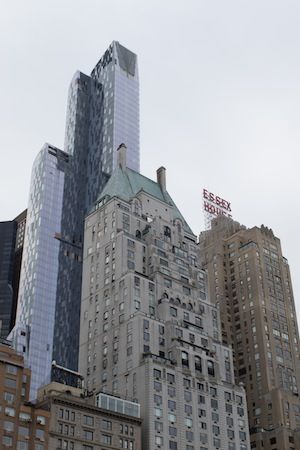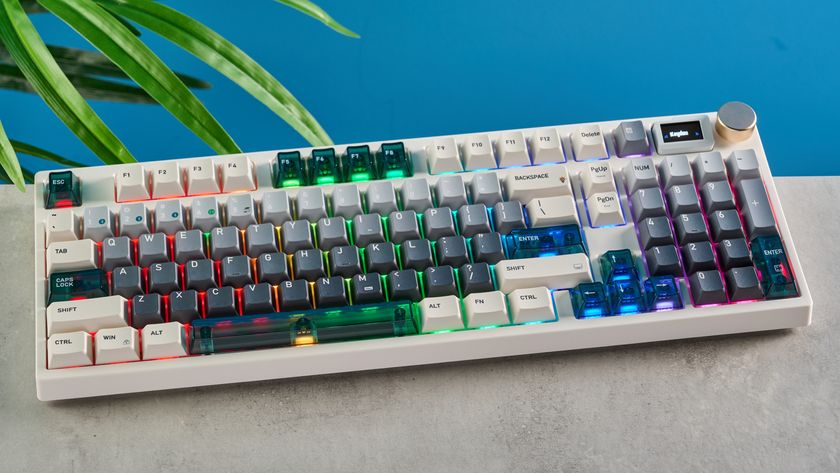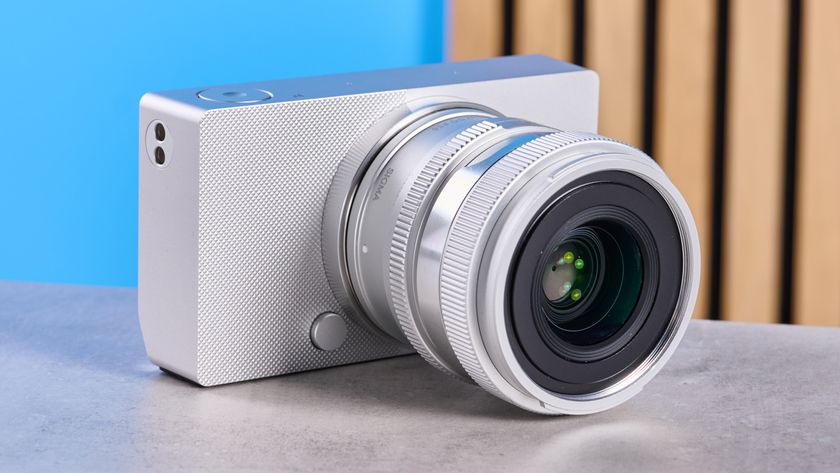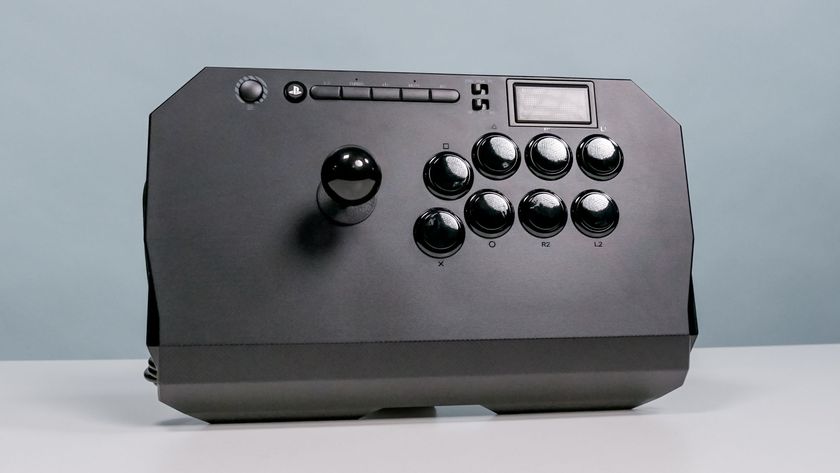Tom's Guide Verdict
One of the fastest DSLRs, the 7D Mark II is ideal for action shooting, but has more image noise than cheaper cams, including Canon's own 70D.
Pros
- +
Fastest autofocus and image processing of any APS-C DSLR camera we've evaluated. Fastest capture rate from any DSLR under $4,000. Translucent LCD overlays helpful information on optical preview.
Cons
- -
Priced as high as some full-frame cameras. Video capability doesn't match that of lower-priced rivals. More noise in high-ISO/low-light conditions than from Canon's own, cheaper 70D.
Why you can trust Tom's Guide
Who it's for: Canon pros who want a second camera primarily for action photography or to multiply the range of their telephoto lenses.
Canon's 20.2-megapixel EOS 7D Mark II is one of the fastest, best-performing DSLRs we have seen. With a $1,800 retail price (body only), it is also one of the most expensive cameras using an APS-C size sensor rather than the larger full-frame sensors that are usually the mark of a professional camera. The 7D Mark II captures images at a top-notch speed of 10 frames per second. For shooting 1080p video, it uses Canon's Dual Pixel AF technology (more about that later) to quickly focus and track even fast and erratically moving subjects.
Canon has positioned the original 7D, and now the 7D Mark II, as cameras for pros who want to extend the reach of their telephoto lenses from their full-frame cameras. Switching to Canon's version of the smaller APS-C sensor increases a lens's telephoto range by a factor of 1.6. The 7D line is also aimed at pros who want a lighter, less-expensive camera for travel. Considering the users Canon is targeting, we subjected the camera to a demanding review to match what pros need. While it excelled in speed and performance, it fell a bit short in image quality, due to pixel noise.
Design and Use: Revised and More Familiar to Pros
Though built around a sensor less than half the size, the 7D Mark II is not much smaller or lighter than a full-frame camera. The new model measures 5.9 x 4.4 x 3.1 inches — just a fraction of an inch less than the 5D Mark III in length, width and depth. At almost exactly 2 pounds each, the 7D Mark II and 5D Mark III essentially weigh the same.
MORE: Best DSLRs

There are some nice upgrades inside the camera. The 7D Mark II uses a transparent LCD screen that sits above the mirror and overlays extensive, customizable information and tools on the optical image preview. These include Canon's first electronic level for a DSLR and a new warning when the camera might encounter flicker in video and photos. (Many lights pulse on and off faster than the eye can perceive but slow enough that a camera captures images at different exposures.)

The 7D Mark II's rear LCD screen has a marginally higher resolution, up from 640 x 480 pixels of the original 7D to 720 x 480 pixels for the Mark II. It's a sharp screen, but it's no match for the clarity of the 720 x 480 OLED screen on the new $1,500 mirrorless Samsung NX1 (see review). In a welcome nod to serious video, the 7D Mark II has jacks for both an external microphone and headphones, to monitor audio levels while you're shooting, as well as an HDMI port to output footage in real time for high-end video work.

The 7D Mark II includes built-in GPS for geotagging photos — something I wish every camera had. (Most pro cameras require expensive add-on modules for GPS.) The camera's built-in flash provides excellent and natural coverage for the frequent instances when photographers don't bring an external flash along.
Even in a tunnel with the camera held sideways, the flash on the 7D Mark II provided soft, full illumination in the photo below. (As with most photo samples in this review, you can click on the image to bring up a larger version.)

Speed and Autofocus: The Real Upgrades
Speed is the main advantage of putting a smaller sensor into a large camera body. It allows for smaller and lighter components that can move faster, and the smaller file sizes from the sensor are easier to process. The result is a one-two punch of fast capture and fast processing times.
The 7D Mark II is one of the fastest DSLRs on the market today — in several ways. First, it's one of the fastest for image capture: Shooting at 10 fps, it's just behind the DSLR speed champ, Canon's 12-fps-capable EOS-1D X ($6,800, body only). It's also fast at processing images, with a buffer large enough to handle 31 RAW files or an astounding 1,090 JPEG images before filling. While Canon hasn't specified the time required to process RAW images and clear the buffer, I've found it to be noticeably faster than with the original 7D.
The camera is also incredibly fast and accurate at focusing on subjects. In DSLR mode, the 7D Mark II uses the same 65-point autofocus system found in the top-end Canon EOS-1D X, but the 7D Mark II improves upon the EOS-1D X system.

The 7D Mark II is the second camera, after the 70D, to use Canon's Dual Pixel AF technology when shooting with the mirror up in live view or video. Most of the pixels on the sensor perform double-duty, capturing image data and working in tandem with another pixel to perform fast phase-detection autofocus during live view.
MORE: Best Mirrorless Cameras

This system also enables face detection for shooting stills in live-view mode or shooting through the viewfinder, which Canon's EOS iTR (Intelligent Tracking and Recognition) combines with information on the subject's distance, color and focus in order to lock on to a subject and track it as it moves. Instead of forcing the photographer to select which of the camera's several focus modes to use, the 7D Mark II presents simple, plain-language choices like "Continue to track subject, ignoring possible obstacles." This is remarkably easier than the complex settings required to track a subject with the Samsung NX1.
On a busy street in New York City, the Canon 7D Mark II kept up with this dancing Salvation Army worker, despite the constant stream of people cutting in front of him.
Overall Image Quality: Inconsistent Based on Lighting
Because the Canon 7D Mark II is aimed at pros, I evaluated it with the same eye I would when reviewing other professional cameras rather than enthusiast models. In that respect, image quality is a mixed bag.
The 7D Mark II is a big upgrade from its predecessor, the 7D. The new camera uses a pair of Canon's latest Digic 6 processors to clean up images, while the 7D used two Digic 4 chips. The newer processors should result in better images even though the 7D Mark II has a slightly higher-resolution sensor (and thus smaller pixels, which can compromise quality). To put this into context, I reviewed several thousand images I had shot with the original 7D when I reviewed it in 2009. The 7D Mark II handily beat its predecessor in many areas, including exposure, contrast and low-light quality.

I also compared photos from the 7D Mark II with pictures from the $1,200 Canon 70D (see review). I found the images produced by the 70D to be less noisy. The ISO 200 images from the 70D had as little noise (graininess) as the ISO 100 images from the 7D Mark II.
Here, we see the detail the sensor is capable of capturing, even in mixed lighting. It shows every drip of oil, every crack and every scratch in the cab of this locomotive. But, due to noise, the image is flat. I had expected less noise at ISO 500.
(Click on images to view larger versions.)

To see if the lighting conditions contribute to the relative noise of the file, I shot this building from f/2.0 to f/22 to rule out the aperture setting from contributing to the noise. Here, at f/16, we can see that there is an incredible amount of noise (graininess) in the building — considering it's a daylight shot at only ISO 200. By comparison, similar building shots I took recently while reviewing the Samsung NX1 are almost completely noise-free at this ISO, as you'd expect for such a low-sensitivity setting.

Here is a 100 percent crop from the same image to show the noise at a pixel-for-pixel level.

However, under brighter lighting conditions, there's almost no noise. Even in the shadow regions — which you'd expect to be noisy due to the wide dynamic range of the subject — the image is crisp and beautiful.

When you find a setting with conditions optimal for the 7D Mark II, the results are stunning. This shot of my son has great detail on his eye and eyelashes, and individual strands of hair are visible.

Another common area where an APS-C sensor has issues relative to a full frame camera is at high-ISO/low-light combinations. The 7D Mark II has much higher ISO capability than the 7D — a recommended range of ISO 100 to 16,000, with the option to go two f-stops higher, to ISO 51,200. That said, image quality declines rapidly as ISO goes up, even to a relatively low ISO 800 in the photo below.

We're already starting to see a marked loss in detail and increase in noise — problems we wouldn't see from a typical full-frame camera at this setting and that I didn't see from the NX1. Detail on the face is particularly poor in this shot, despite the camera's usage of face-detection autofocus. The skin tones are blotchy, and the shirt is dark and missing detail. Quality continues to decrease noticeably as the ISO climbs.
Here, at ISO 10,000, things get pretty grainy but much, much less so than the original 7D could ever hope to achieve. The older model would show a similar level of noise down to about ISO 4,000.

Because the noise here is uniform, I've found that just a touch of adjustment using luminance noise reduction in an editing program vastly improves the image. But again, because of the price of the 7D Mark II, the benchmark here is a pro full-frame camera, whose photos are cleaner straight out of the device.
Video Quality: OK
The full-frame Canon 5D Mark III is $1300 more expensive than the 7D Mark II (based on list price) and is renowned for its video quality. Because the 7D Mark II is a brand-new system with the new Digic 6 processor, you'd expect top-notch video. But the quality is not exceptional, and has a level of noise and jerky playback that are absent from cameras like the 5D Mark III.
While the 7D Mark II uses fast phase-detection autofocus while shooting video, it uses a secondary system for face detection in live-view mode.
Video taken by the unflattering light of New York City subway stations was surprisingly attractive, with the camera's automatic white balance neutralizing the harsh fluorescent lights. Using face detection, focus stayed put on this woman in this pair playing traditional Chinese instruments on the platform. She remains relatively sharp even as we move about to get closer and a different angle.
The 7D Mark II also passed one of our favorite autofocus torture tests: trying to keep focus on a subject as a flood of commuters continually passes by.
The 7D Mark II generally keeps its focus point on the guitarist's face, as you can see in this video showing the camera's rear screen. (We captured this quickly using an iPhone.)
Perhaps the 7D Mark II fails to impress partially because there have been so many new cameras recently with truly groundbreaking video at a similar price. These competitors include the Samsung NX1 and the $1,500 Panasonic Lumix DMC-GH4, which shoot 4K video and produce truly stunning quality at a similar lower price. (Sony's $2,500 Sony A7s also shoots excellent 4K, and it's especially capable at very high ISO settings.)
Controls: Pro All the Way

The control layout of the 7D Mark II is all-pro, and follows Canon's typical professional layout. Atop the camera is the mode control dial, which is devoid of scene settings, such as Portrait, found on amateur cameras.
The left side of the camera's back (when you're facing it) contains new Menu and Info buttons, as well as a button to control the picture settings (Vivid, Natural, etc.) for JPEG images, and playback control buttons for reviewing images. The other side of the viewfinder includes live-view controls. The same ridge on the top of the camera has the AF controls.
MORE: Nikon D810 Review: Best Pro DSLR
Below that is the thumb control with a new toggle switch, the Q button for quick access to camera settings and the traditional rotating command dial with a Set button in the center. This button can be locked via a large and easily accessible toggle switch. For details on the camera's usability, see the table at the end of the article with the number of steps required to reach key settings.
Battery Life: A Bit Short
The Canon 7D Mark II battery is rated for 670 shots. This is not only lower than the figure for the Canon 5D Mark III (950 shots) but is even below the original Canon 7D (800 shots). While I didn't completely run out of juice during any of my shoots, none were full-day affairs. Based on the 670-shot rating and my experience, I recommend bringing a backup battery (around $80) to a full-day shoot. Still, battery life is far better than you'll find on a mirrorless camera; the Samsung NX1 is rated for just 500 shots.
Wireless and GPS: Mixed Bag
The 7D Mark II has GPS built in and can geotag images automatically. (Using GPS will curtail battery life, but GPS is off by default.) This is an incredible feature — one that's often offered in amateur cameras and should be standard in pro-camera bodies. Having GPS data in your photos really enhances image search and categorizing.
The 7D Mark II also includes a digital compass, so it can log the direction the camera was facing for each photo. All of this needs to be configured in the custom menu, along with the frequency of the polling of the GPS data (the less often you check your location, the longer your battery will last) and whether the camera tracks a separate log file — which is helpful if you'd like to overlay your shoot on Google Earth or other tracking software.

The 7D Mark II does not include built-in Wi-Fi, which is a shame because it would allow for remote shooting over Wi-Fi and the transfer of images without a card reader or USB cable. Canon's optional WFT-E7 attachment provides Wi-Fi connectivity — and a much better range than built-in Wi-Fi in other cameras typically provides — but it costs around $850. Despite that long range, I'd rather see wireless built in.
Lenses and Accessories: Huge Selection
The Canon 7D Mark II is compatible with Canon's full line of nearly 100 current APS-C and full-frame lenses as well as third-party lenses. Many of the APS-C lenses available are aimed at the amateur or the enthusiast: There are a lot of slow, variable f-stop zoom lenses (such as f-3.5-f-5.6) in the lineup, but also some faster models. And you can use any of the full-frame lenses.
For the sports and nature photographer, the ability to take a full-frame lens and extend the reach by a factor of 1.6 might be reason enough to buy the 7D Mark II. Take a 300mm telephoto into the veldt, and with the Canon 7D Mark II, you're shooting at an equivalent of 480mm. There are countless accessories for the EPS system, from macro kits to strobes to the Canon BG-E16 vertical grip/battery pack.
I tested the 7D Mark II with Canon's sharp 35mm f/1.4 full-frame lens ($1,500) and its 18-135mm f/3.6-5.6 lens ($500). The 35mm lens produced cleaner images with better aperture-based subject blurring, and the lens felt more appropriate for a professional-level camera.
Like all variable f-stop lenses, the 18-135mm felt like a compromise — one that few photographers spending $1,800 on a camera body are likely to want to make. As a result, I anticipate that users of the Canon 7D Mark II would benefit the most from working with full-frame lenses — which, of course, defeats some of the purpose of working with an APS-C system camera, since the pro lenses are so large and heavy to accommodate the full-frame sensor.
Bottom Line

The Canon 7D Mark II is an incredibly powerful, exceptionally fast camera and the fastest remotely affordable DSLR on the market. However, its image quality is just below what you'd expect from this type of camera, and as a result, less-expensive cameras like the Canon 70D and recent high-end modelsupstarts like the mirrorless Samsung NX1 produce better-looking images.
The 7D Mark II maximizes the range of Canon lenses and accessories, and for Canon shooters who need high speed, it's the best-performing device on the market. Sports and nature photographers who prefer Canon will love the reach of the APS-C sensor crop and the ability to track nearly anything, no matter how erratically it moves. However, if speed isn't at a premium, these photogs can get nearly the same autofocus performance, and less-grainy images, from the cheaper Canon 70D.
People prepared to spend nearly $2,000 on a camera body might be happier with a full-frame camera, such as the Sony A7 mirrorless series ($1,500-$2,000) or even a Canon 6D DSLR ($1,800) if they value image quality more than speed.
Controls in Detail
The table below shows the number of steps required to access each key camera setting. A setting that has a dedicated knob or button requires zero steps to access. The extensive physical controls on the 7D Mark II make it exceptionally easy to use.
| Setting | Number of Steps | Description |
|---|---|---|
| Shutter | 0 | Length of exposure |
| Aperture | 0 | Amount of light let in |
| ISO | 1 | Light sensitivity |
| Focus mode | 1 | Point or points used for focus |
| Light metering | 1 | Part of image with optimized exposure |
| White balance | 1 | Overall color cast of image |
| Exposure compensation | 1 | Set autoexposure to be darker or lighter |
| Video recording | 1* | Switch from photo to video and back |
| Play | 0 | View images or videos you've shot |
| Delete imag | 2 | Erase photo from memory card |
| Photo capture resolution | 2** | Set number of megapixels |
| Photo capture quality | 2** | Level of compression |
| Video capture resolution | 3 | Lines of resolution and frame rate |
| Video capture quality | 3 | Amount of compression/detail |
| Drive | 1 | Single photo, burst, timer, etc. |
Notes:
*If switching from DSLR mode. Zero if in live view mode.
**1 if shortcut button programmed
Key Specs
Model name: Canon EOS 7D Mark II
Megapixels: 20.2
Camera type: DSLR
Shooting speed: 10 fps
Sensor type: APS-C
Kit lens options: EF-S 18-135mm f/3.5-5.6 IS
AF points and type: 65-point full cross phase detection (SLR mode)
Shutter speed range: 1/8000 to 30 seconds, bulb
ISO range: 100 - 51,200
Main video resolutions/frame rates: 1920 x 1080 (50/30/24fps)
Video file formats: MOV, MP4
Built-in flash: Yes
Hot shoe: Yes
Card type: CF, SD/SDHC/SD
Ports: USB 3.0, mini HDMI out, audio-in/mic, headphone
Shots per charge (CIPA standard): 670
Wireless capability: GPS (Wi-Fi via add-on)
Image stabilization: Select lenses
Dimensions and weight: Approx. 5.9 x 4.4 x 3.1 inches, 32.1 ounces (body only)
-
Blue Boy Not sure I understood your test for inconsistent image quality based on lighting. In particular the building shot at f16 and ISO 200. Did you raise exposure in post? Or was the ev sufficient to properly expose the image.Reply -
David Schloss Reply15419005 said:Not sure I understood your test for inconsistent image quality based on lighting. In particular the building shot at f16 and ISO 200. Did you raise exposure in post? Or was the ev sufficient to properly expose the image.
Those are untouched images (except for recompressing the jpeg to post online.) Exposure wasn't raised, the daylight was easily enough light for a much better result. -
David Schloss No, the shots were all appropriate exposures for the lighting conditions. Which was our point about the image quality.Reply














